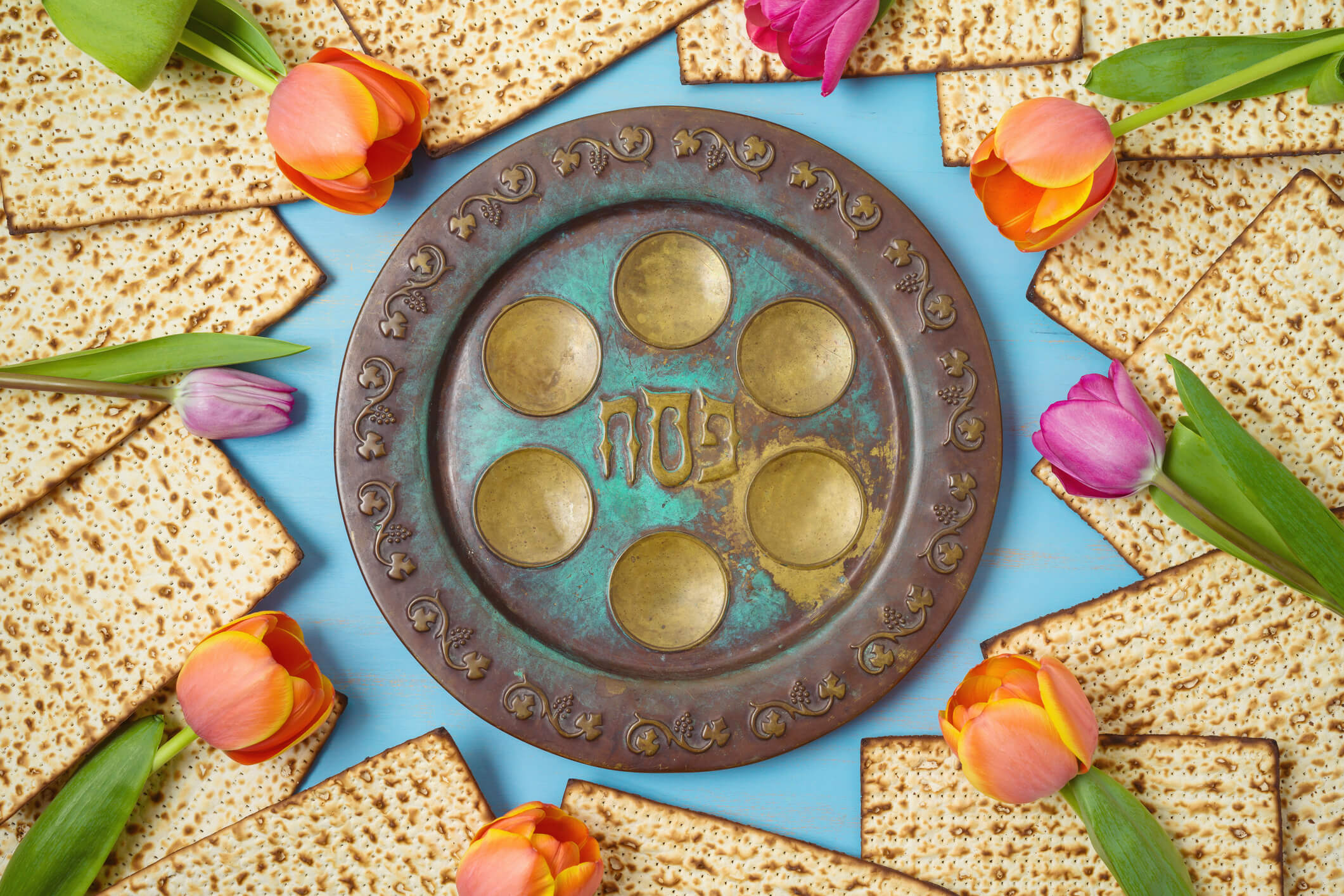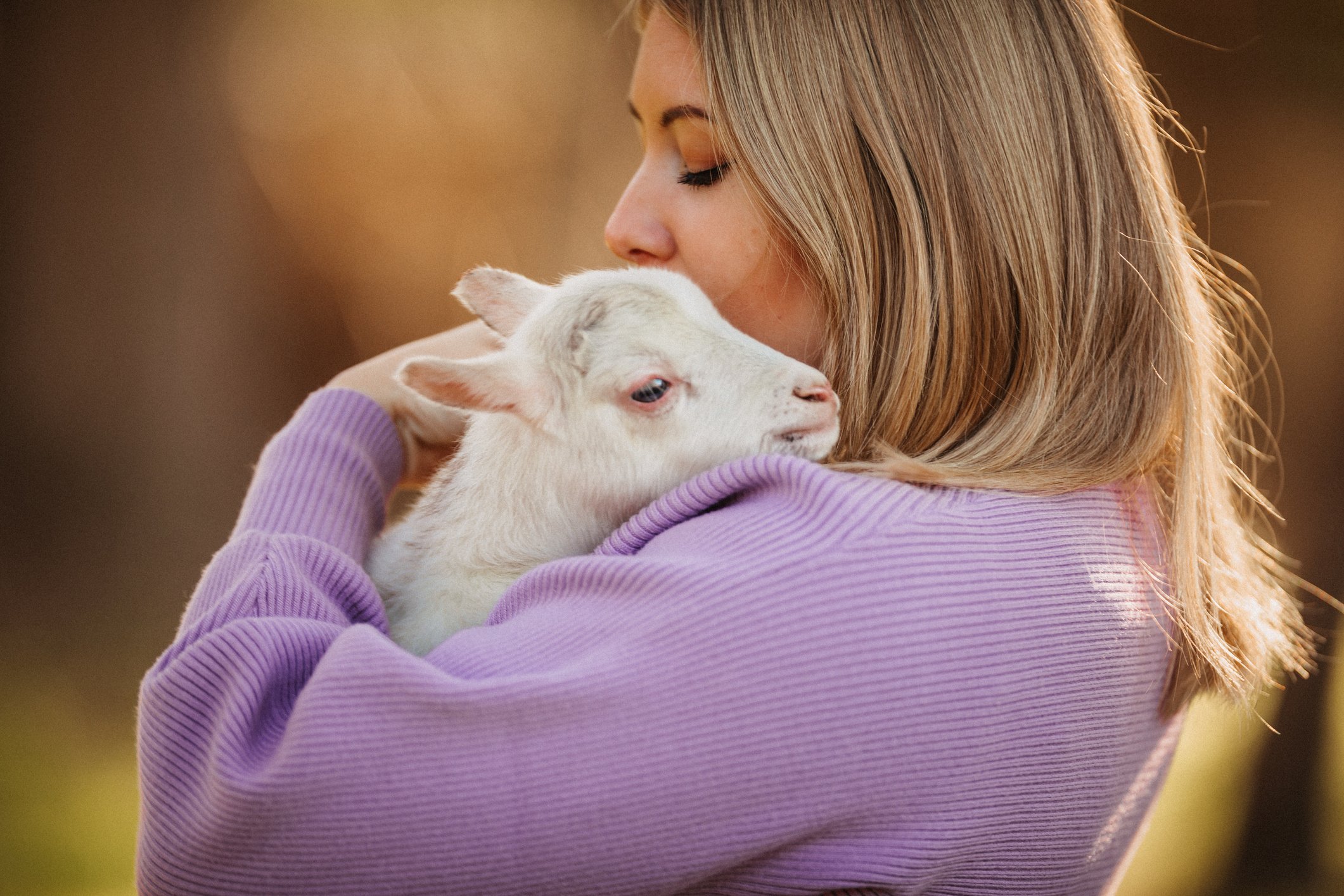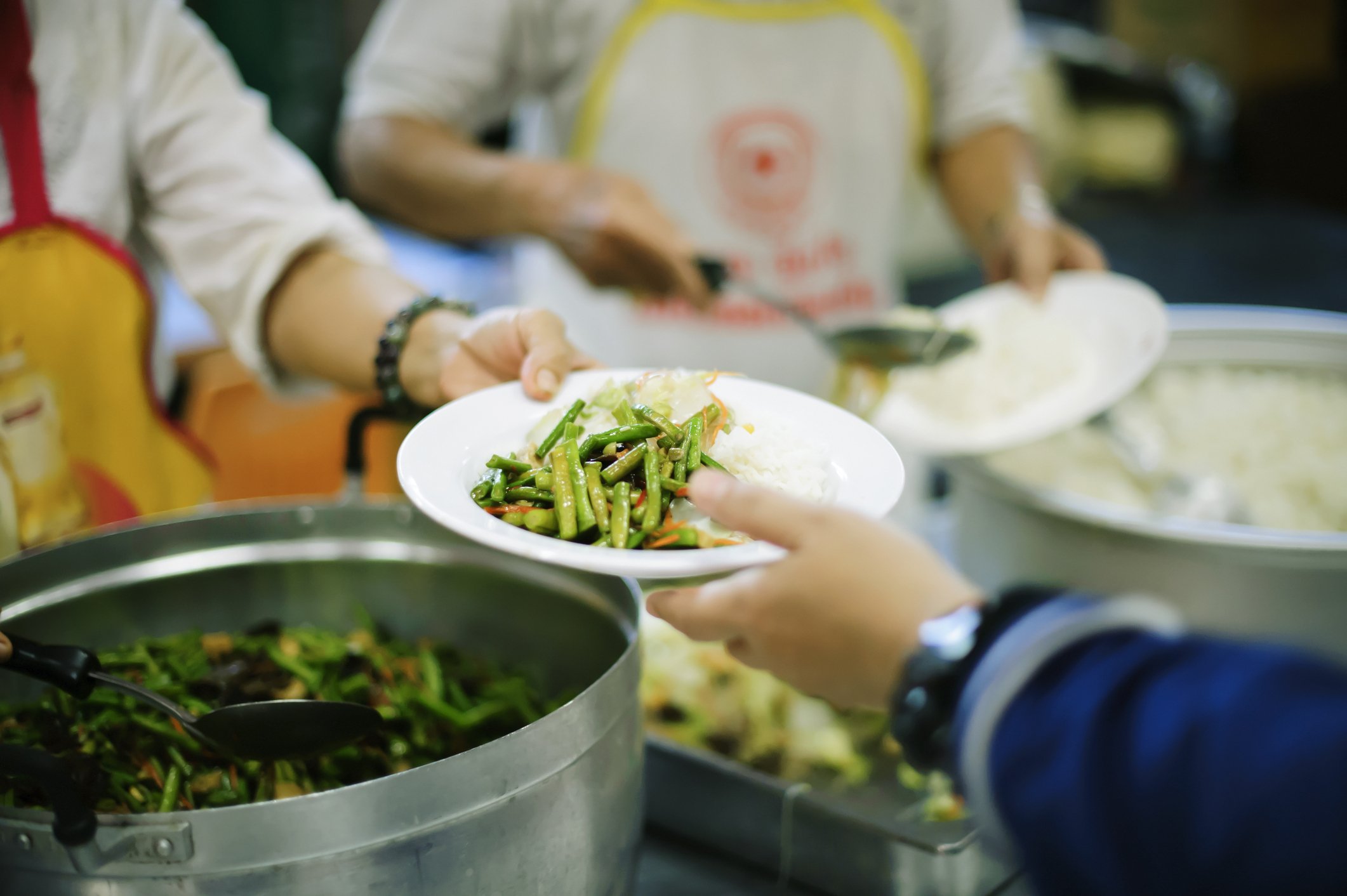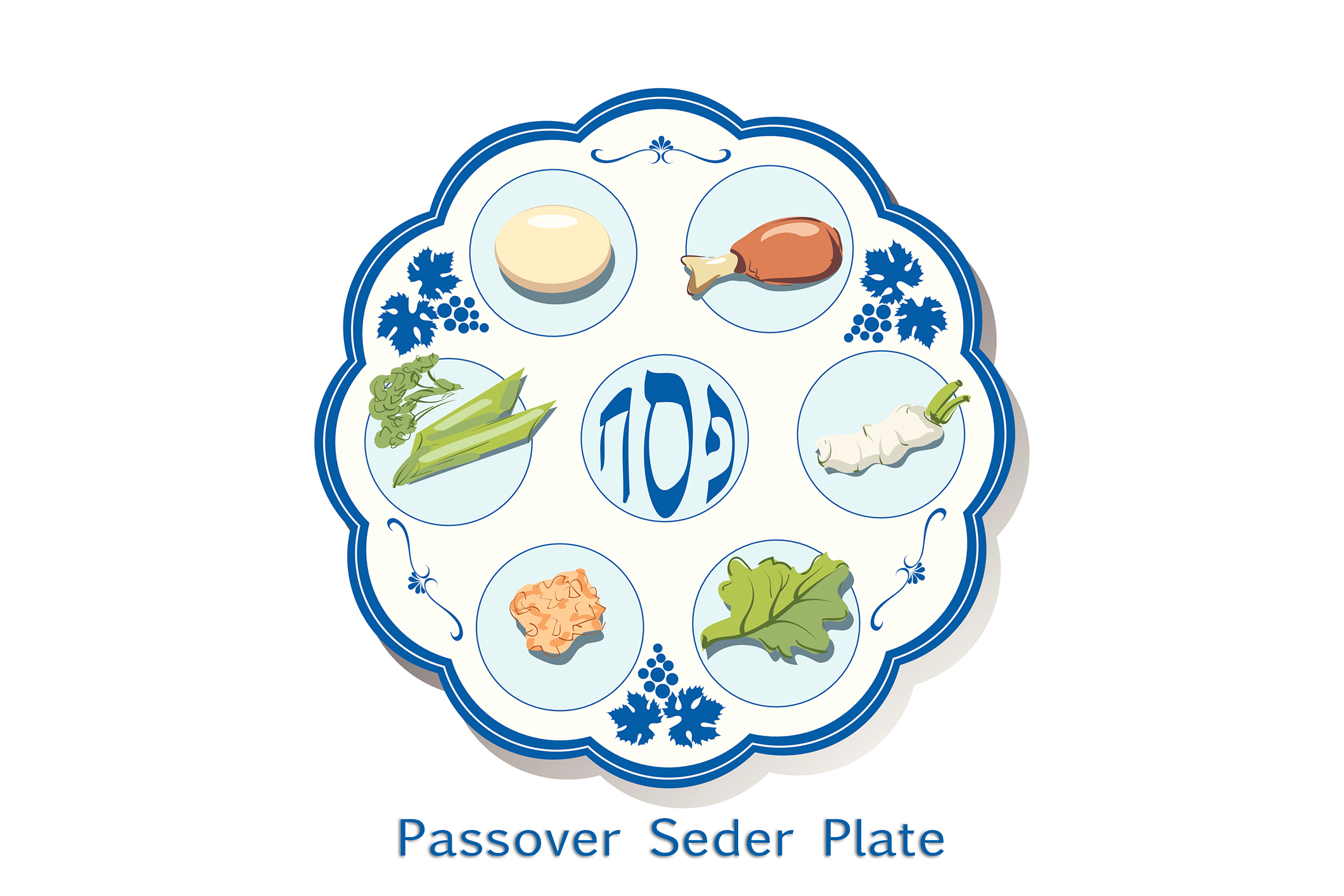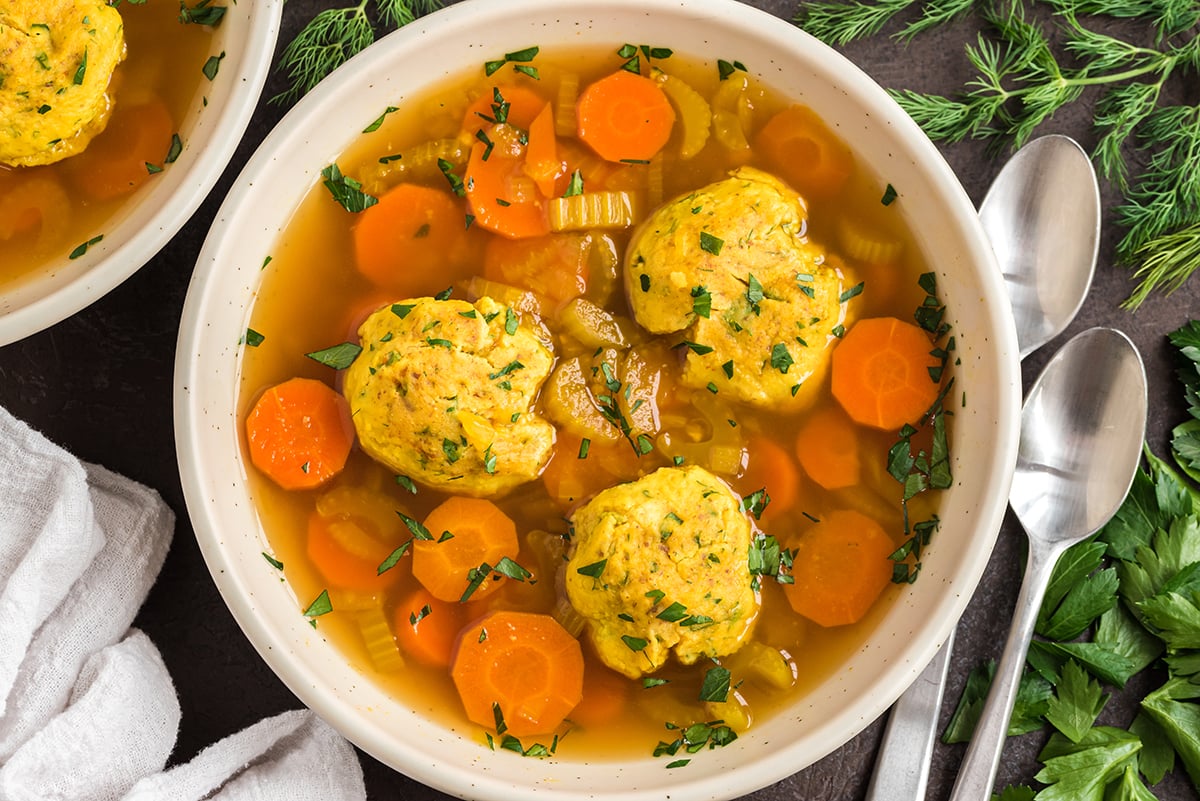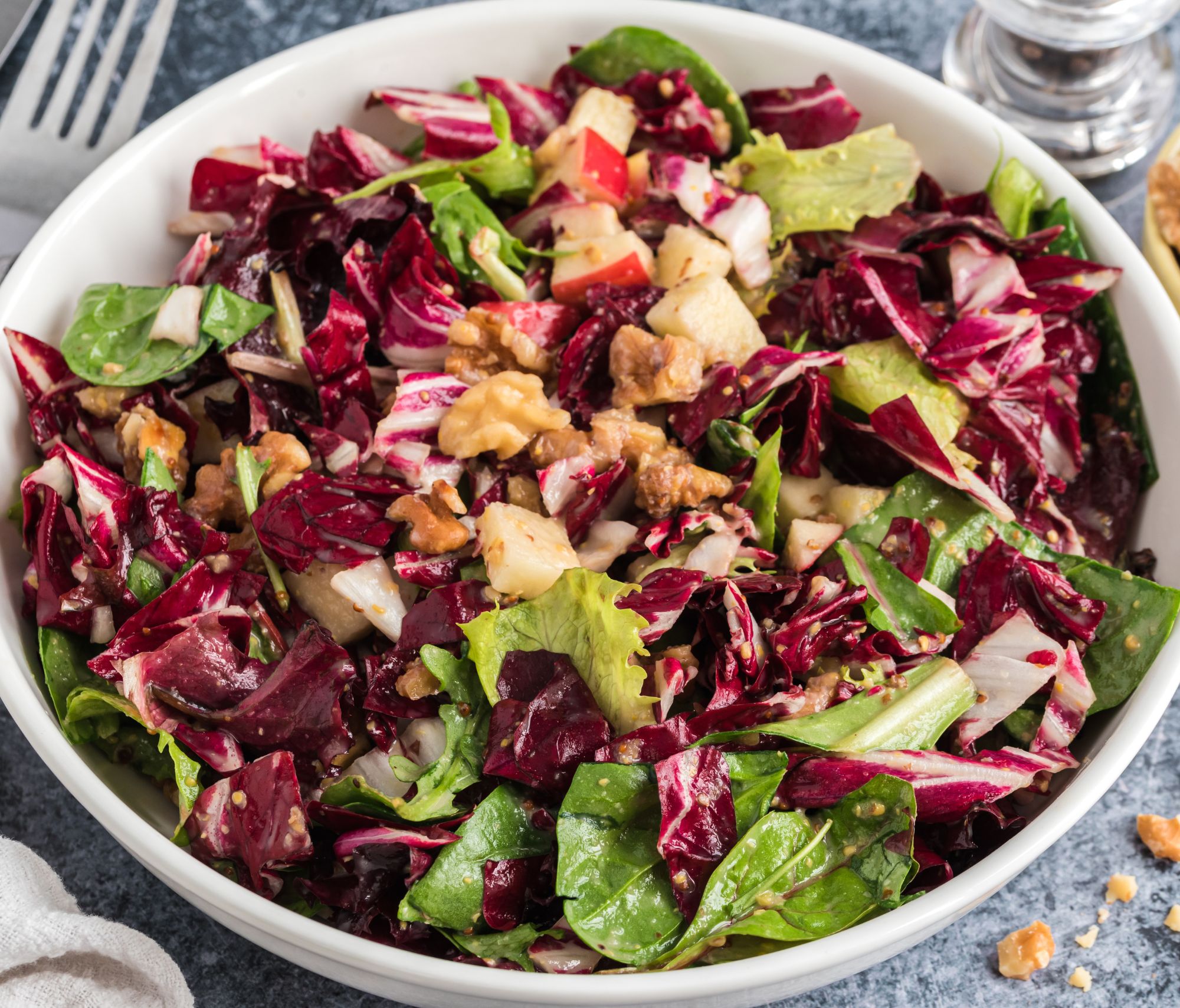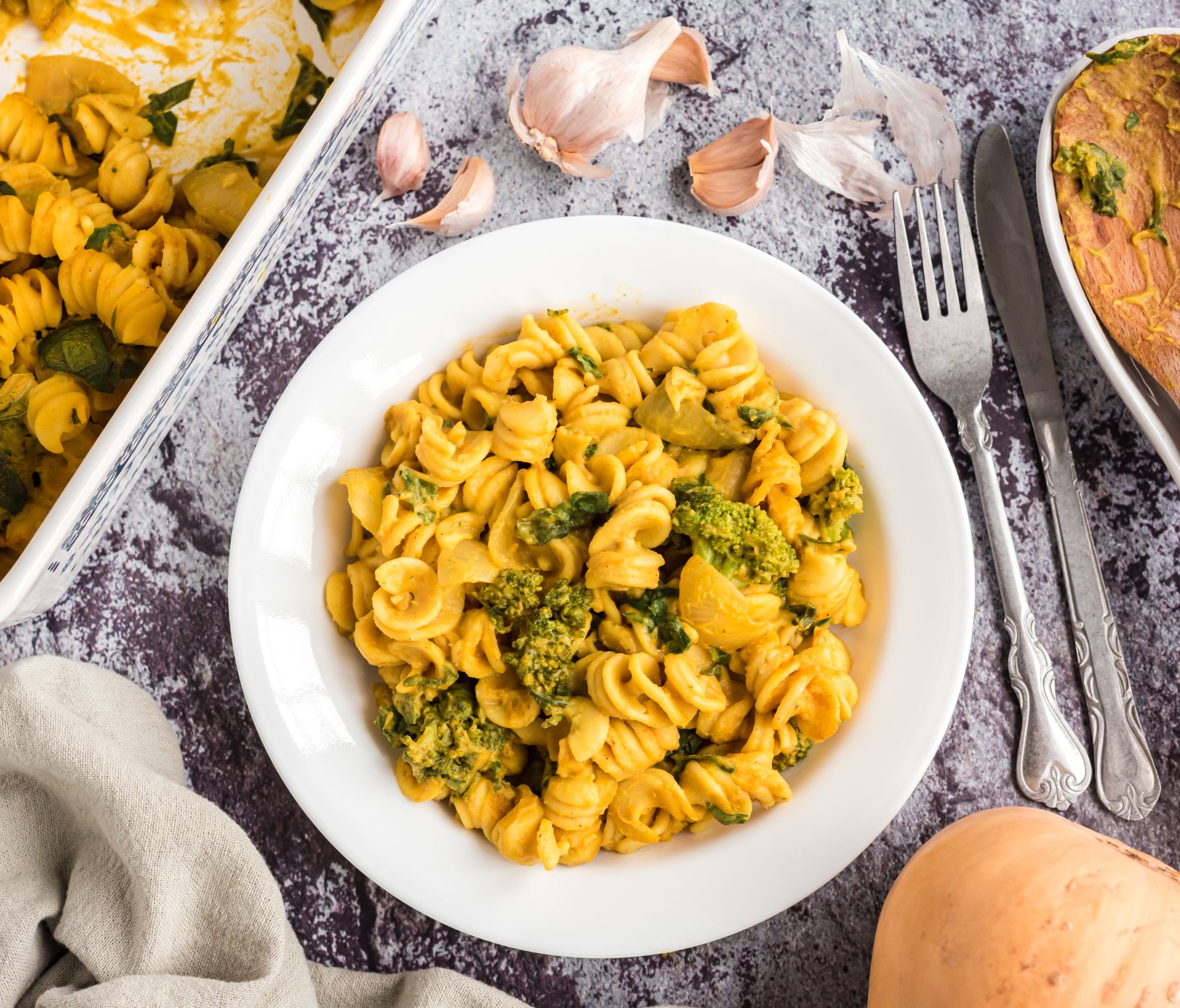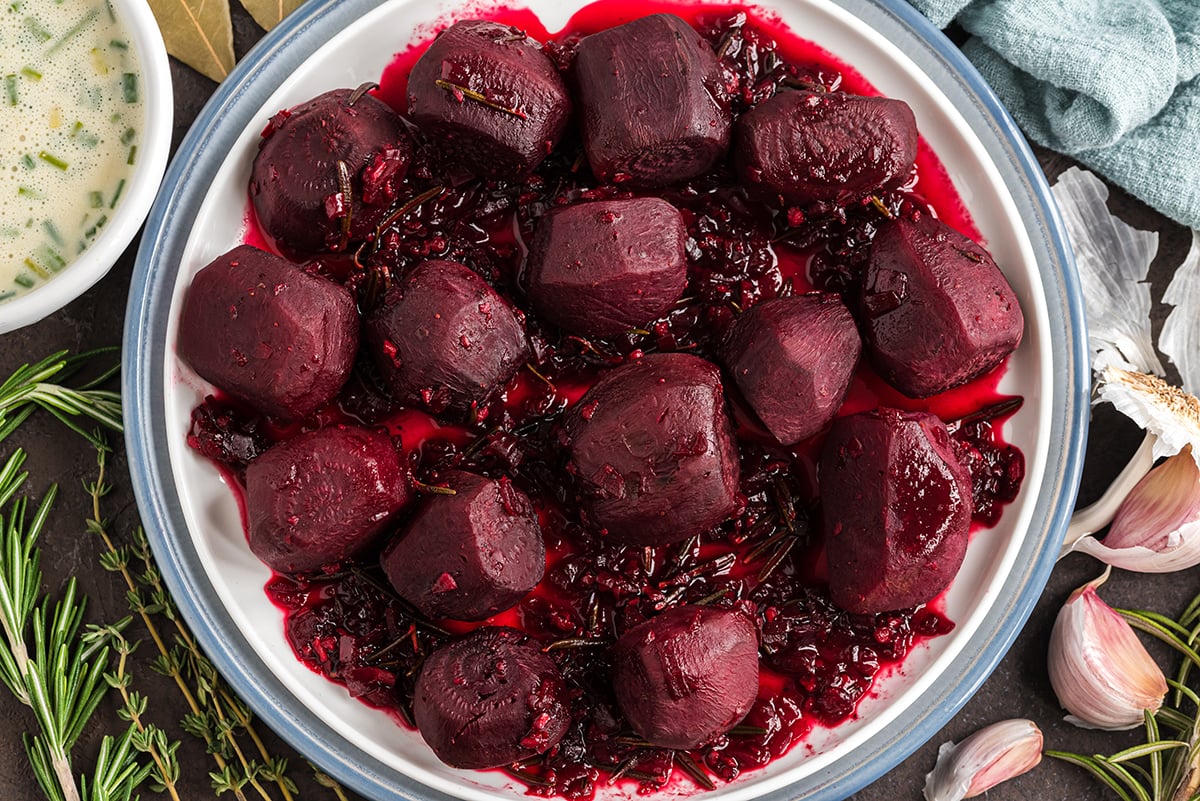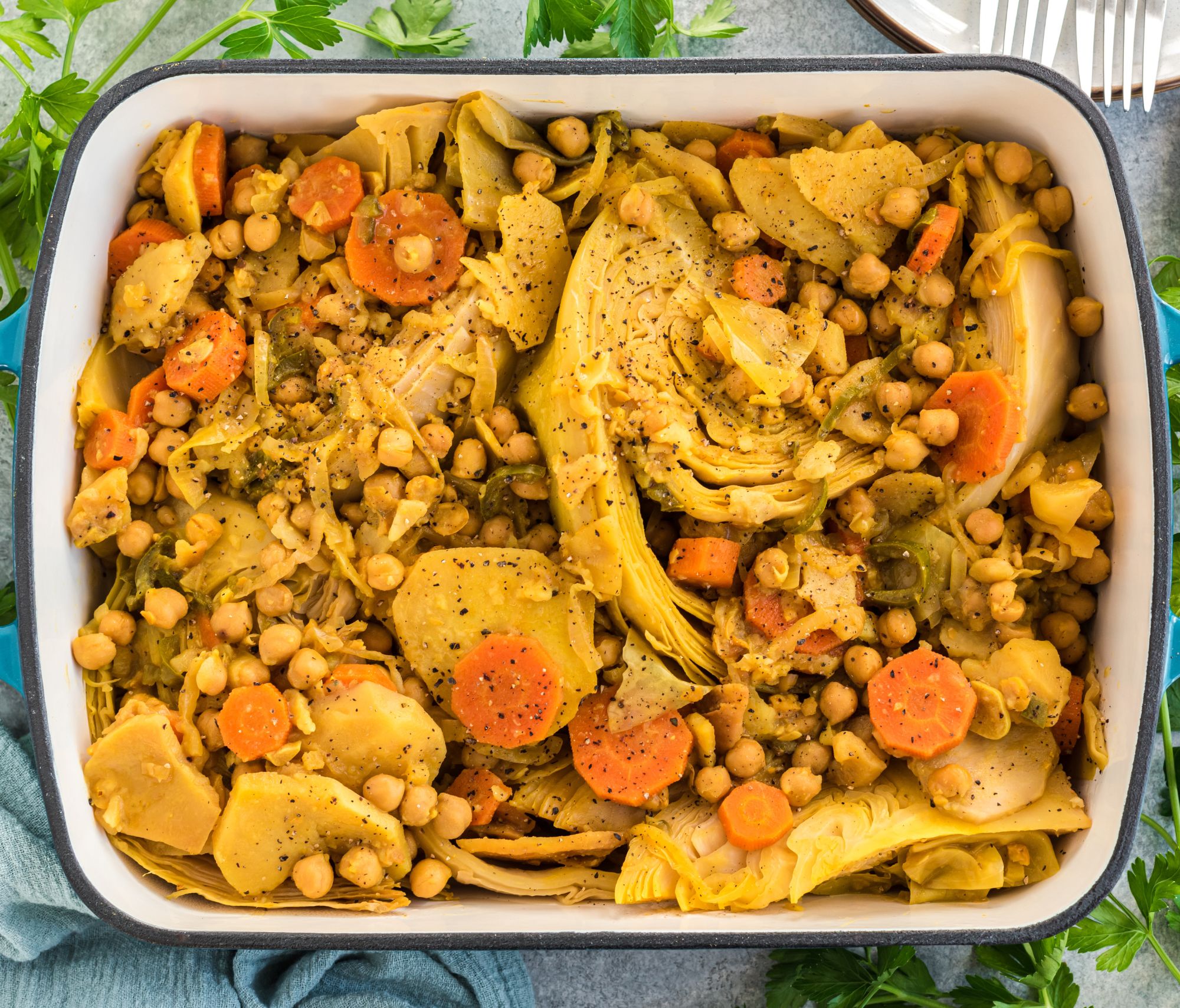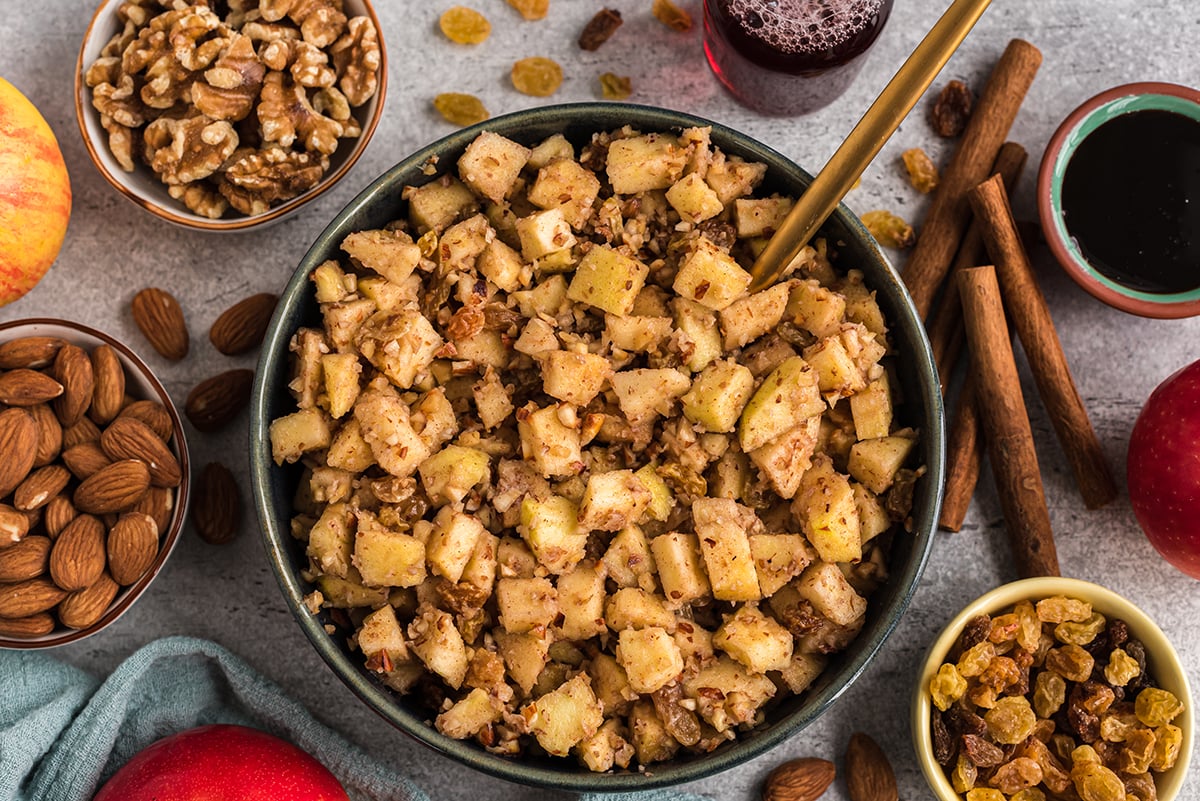Baked chicken or braised brisket for Friday night dinner. Smoked salmon and herring in cream sauce on Sunday morning. Chicken soup whenever you got the sniffles. And pastrami on rye from the 2nd Avenue Deli on special occasions. These dishes were as much a part of my Jewish identity, growing up in 1970s New Jersey, as any religious rite.
In short, I learned that eating animal-based foods was not only totally okay in my tradition, but expected. And in the case of the springtime Passover holiday, or Pesach, it was required.
The ritual meal that occurs the first two nights of Passover is called the Seder (which means “order,” as there’s a list of 10 rituals that must be completed in order). And there are a couple of foods of animal origin that appear on the Seder plate: a shank bone and a hard-boiled egg.
At the same time, there’s a strong ethical tradition within Judaism that seems to argue against eating animals. When I started flirting with vegetarianism in my mid-teens, it seemed a logical extension of what my religion had taught me about compassion, justice, and my responsibility toward the world and its creatures.
And it turns out, I wasn’t alone as a Jew exploring a plant-based diet. Israel has the highest percentage of vegans per capita in the world — approximately 5% of the population. According to Google Trends, Israelis are among the global leaders in searches on the topic of veganism. And if you don’t mind some name-dropping, the following celebrities (at the time of this writing — fame is fleeting) are members of both the vegan and Jewish communities: Natalie Portman, Mayim Bialik, Peter Singer, and Alicia Silverstone. If we expand into vegetarians, we can also claim Franz Kafka, the Alberts (Einstein and Schweitzer), Allen Ginsberg (can we call him a “beet” poet?), the Spocks (Dr. Benjamin and Leonard Nimoy’s Mister), Ed Asner, and Scarlett Johansson. Also the musical Leonards: Cohen and Kravitz.
In this article, I’ll explore the synergies between veganism and Judaism, in general, and Passover, in particular. We’ll see how Jewish vegans can navigate this eight-day holiday in ways that honor both tradition and personal ethics. And we’ll conclude with some yummy, vegan Passover recipes crafted by the culinary geniuses here at Food Revolution Network.
The Judaism-Veganism Connection
There are several core aspects of Jewish ethics that are incompatible with — if not eating animals — at least the way industrialized animal agriculture handles livestock, humans, and the environment today. These ethics include treating animals with kindness, making sure that all people are fed, caring for the environment, and valuing and preserving human life and health.
Kindness to Animals
There are several admonitions against cruelty to animals in the biblical tradition.
Exodus 23:5 says, “If you see that your enemy’s donkey has collapsed under its load, do not walk by. Instead, stop and help.” Deuteronomy 22:10 forbids a farmer from yoking an ox and an ass together on one plow since the difference in strength would cause suffering for both. And the basis of the set of kosher laws to not eat meat and dairy simultaneously is rooted in the simple admonition, “Do not boil a kid in its mother’s milk,” which occurs three times in the Five Books of Moses.
The book of Genesis also appears to portray meat eating as a no-no. The AirBnB instruction booklet for the Garden of Eden would probably imply that animals are not on the menu: “Behold, I have given you every herb yielding seed which is upon the face of all the Earth, and every tree that has seed-yielding fruit — to you, it shall be for food” (Genesis 1:29). It’s only many generations later, following the flood that nearly wiped out all of humanity because of their wickedness, that the divine rules bend to accommodate a human weakness for animal flesh.
The living tradition of Judaism has reflected this uneasy compromise. In fact, the kosher laws themselves are all about restrictions on how and when one can eat foods of animal origin. The commandments that pertain to ritual slaughter all mandated the most humane, least painful methods available at the time. (The most humane thing, I’d argue, is not to kill them for food in the first place, which is always an option.)
Feeding the Hungry
Giving food to those who are hungry and in need is a fundamental human responsibility. Isaiah 58:7-8 says that when you “share your bread with the hungry, your light breaks forth like the dawn, and your healing shall spring up speedily, your righteousness shall go before you, the glory of the Eternal shall be your rear guard.” (Now that’s what I call some serious incentives — it’s like the world’s first infomercial: “But wait — there’s more!”)
One of the main causes of global hunger in the modern world is the inefficient use of agricultural land. Globally, animal agriculture uses up 83% of all arable land while producing just 18% of the calories that end up in human bellies. Eating plant-based can help increase the food supply for people, by eliminating the waste and inefficiency that occurs when we cycle calories through livestock. This can increase supply and also lower the price of food, making it more accessible to those with the fewest resources.
Find out more about how your food choices can impact world hunger.
Caring for the Environment
The Jewish tradition also emphasizes a strong environmental ethic. Biblical laws include Deuteronomy 20:19, which forbids an army that’s besieging an enemy city from cutting down its trees; and Leviticus 25:23, which prohibits perpetual land ownership, because “the land is mine” (i.e., God’s). Considering the environmental costs of animal agriculture, including global climate chaos, habitat loss, and pollution, many contemporary Jews see plant-based eating as a moral imperative for protecting the planet.
Climate change has exacerbated droughts in many parts of the world. And animal agriculture is one of the largest depleters of water. As such, going vegan may enable better stewardship of this precious natural resource.
Another agricultural practice that’s causing environmental devastation is monocropping or the growing of a single crop over huge areas with no diversity. From pesticide and herbicide exposure to habitat loss to the increased risk of predators or pathogens wiping out an entire crop, monocropping threatens entire ecosystems and populations. And much of the monocropped land produces feed for livestock. So avoiding meat and dairy can reduce the demand for this agricultural practice.
For more on this topic, read our article on how your food choices can shape the future of life on Earth.
Preserving Human Health
The Jewish tradition values human life above almost every other value. This concept, Pikuach Nefesh in Hebrew, has been interpreted to mean that it is permitted to break the Sabbath in order to drive someone to the hospital to save their life.
Given what we know about the links between animal foods and chronic conditions like heart disease and type 2 diabetes, choosing to eat a plant-based diet is very much in line with that principle.
A Brief Explainer of Passover
The Jewish tradition, in general, often aligns with the ethical aims of veganism, but what about Passover itself? Passover teaches five valuable lessons for living an effective and successful life: Remembering the past, taking responsibility, staying optimistic, valuing family, and empathy for others. Might these also align with a vegan lifestyle?
Memory and Obligation
Passover commemorates the exodus from Egypt; the story of how an enslaved people achieved freedom. But the Passover Seder is more than a retelling of the story; it’s a reenactment. The foods on the Seder plate are meant to evoke a somatic response: dipping greens in salt water for tears, eating bitter herbs for hardship, chewing on hard, dry matzah, called the “bread of affliction,” to bring ourselves directly into the experience of oppression.
The Seder’s instruction manual, the Haggadah (literally, “the telling), includes this gem: “In every generation, a person must regard themself as though they personally had gone out of Egypt.” The Seder is a metaphorical and food-based experience that reminds us about oppression. And with that knowledge comes the obligation not to oppress others, especially those who are most vulnerable.
Considering that animals are very vulnerable, especially when they are in our care, this sounds like a pretty good reason not to mutilate and cage them in factory farms.
Choice and Responsibility
We remember a most painful time in our history not to wallow in misery, but to experience the transformation from enslaved to free. Interestingly, the word for Egypt used in ancient Hebrew texts is “Mitzrayim,” which translates to “the narrow places.”
Schools of mystical Kabbalistic Judaism read the entire holiday of Passover as a metaphor for the human journey to liberation. Most of us can recognize “narrow places” in our own hearts and minds — conditioned responses to the world, other people, and ourselves that are rooted in fear or false pride.
The Seder lays the choice out before us: we can remain in the narrow places out of fear or habit, going about our lives ignoring most of the suffering that’s around us. Or we can expand our consciousness far beyond ourselves and our immediate environment, and extend our compassion to the entire world.
Hope and Optimism
One of the recurring motifs of the story of Passover is just how “not into it” a lot of the Israelites were. Many of them feared the unknown future more than the oppressive present. And once they were out of Egypt and in the desert, they freaked out and demanded to return to the place where they knew they would get fed and housed.
The Seder is an opportunity to embody hope in the midst of hopelessness. To strive toward a better tomorrow even though its outlines are too fuzzy to apprehend. To take individual action to make the world better, even as part of us cowers at the enormity of the problems we face.
Distributed Leadership
Arguably, Moses is the protagonist of the Passover story, with the Egyptian ruler, Pharaoh, assuming the role of villain. And indeed, Pharaoh gets a lot of air time in the Haggadah. But do you know who isn’t mentioned? Moses. (Technically, his name appears in a very esoteric discussion among a bunch of later rabbis about the exact number of miracles that God performed, but you get the idea.)
There are many possible explanations for this omission, but my favorite is to encourage people not to put their faith in leaders and not to despair when a leader isn’t present, but rather to become the leaders they’ve been waiting for.
This squares perfectly with a plant-based approach to making the world a better and kinder place. We don’t have to wait for a leader or for any particular party to win an election, or wait until laws change. We can “be the change,” and participate, with our individual actions, in what could become massive communal and even global transformations.
Modeling to Evoke Curiosity and Empathy
The Seder kicks off with a child (or the youngest person present) asking the “four questions.” They begin with the general query, “Why is this night different from all the other nights?” And each question is triggered by something on the table that’s out of the ordinary: dipping bowls full of salt water; flatbread instead of a risen loaf; a couple of bitter vegetables. There are also cushions to recline on rather than sitting up straight at the table.
The Seder is like an interactive theatrical experience that’s initiated by a person who’s curious about what they’re seeing. Plant-based eaters can also stimulate curiosity in others who see us choose vegan options in place of more familiar animal-based foods. When we live in harmony with our values, we can stir the question, “Why is this person different or doing things differently?” So our daily choices can also become an expression of our advocacy.
Veganizing the Haggadah and Seder Plate
While we’ve already seen that a bone and egg are traditional elements of the Passover Seder ritual, most of the other items on the Seder plate are already plant-based.
- Karpas: a raw vegetable, often parsley or celery, that’s dipped in salt water to represent new life
- Matzah: the unleavened bread that symbolizes hardship and recalls the hasty flight from Egypt that didn’t leave enough time for the dough to rise
- Maror: the bitter herb, often a horseradish root, that recalls the bitterness of our ancestors’ suffering under slavery
- Charoset: a sweet mixture of chopped fruits, nuts, and wine that looks (but fortunately doesn’t taste) like the mortar used by Israelite slaves
- Hazeret: the second bitter herb or vegetable, often romaine lettuce or endive
The shank bone recalls the lamb slaughtered to provide sustenance and strength to the fleeing Israelites, and the blood painted on their doorframes to signal to the Angel of Death to “pass over” those homes while visiting the last of the 10 plagues on the Egyptians.
The egg symbolizes the continuation of life; the rebirth from slavery to freedom. As part of the ritual, it’s dipped in salt water to remind us that life, while good, can also provoke tears.
If you go beyond the symbols and look at what they represent, you can easily substitute other food items that don’t require animal suffering to produce.
In place of a shank bone, vegans can substitute a roasted beet to invoke blood. This isn’t a modern innovation either. The ancient tractate (written work) of the Babylonian Talmud religious text that deals with Passover permits the use of a beet in place of an animal bone.
Other modern takes on a veganized shank bone include two mushrooms held together by a toothpick or skewer (resembling a bone), and a pomegranate, whose red juice is also evocative of blood.
In place of the egg, Jewish Veg suggests a flower, invoking the promise of spring “without contributing to the pain and misery of egg-laying hens.” Another symbol of the potential for new life is the seed, so a small pile of sunflower or sesame seeds can also serve. And vegan cookbook author Nava Atlas reminds us that a boiled and peeled white potato can preserve both the shape of the egg and its ability to taste yummy after being dipped in salt water.
Jewish Veg has created a vegan Haggadah that you can download, print, and use at a Pesach Seder.
Vegan Passover Seder Recipes
Ready for a vegan Passover meal? Angelic Deviled Potatoes can rock the Seder plate in place of eggs or get served as a side dish. Warm up with a bowl of Matzah Ball Soup and Creamy Plant-Powered Kugel for some traditional Jewish comfort food. And for a hefty dose of veggies, we’ve got Slow Cooker Alicha Denich and Chicory Salad (Hazeret) with Sweet Mustard Dressing. Let’s not forget our take on the Seder shank bone with the Beet “Shank bone” Braised in Horseradish Cream Sauce. Last but not least, we have a Classic Charoset — made with unsweetened grape juice instead of wine — that adds a delicious sweetness to your Passover Seder. Yum!
1. Angelic Deviled Potatoes
Angelic Deviled Potatoes are a fantastic way to kick off your vegan Passover feast. Potatoes and tofu create a creamy appetizer, similar to a deviled egg, that will satisfy your belly and wow your Passover guests. Keeping Passover traditions alive through vegan food never tasted so good!
2. Matzah Ball Soup
Matzah Ball Soup is an essential addition to any Passover recipe round-up! Our version uses fresh parsley and dill in the chickpea-based matzah balls for a plant-based twist. The delectable broth features fresh veggies and herbs for maximum flavor. This delicious plant-based soup will warm you up and bring your family together during the Passover season — what could be better?
3. Chicory Salad with Sweet Mustard Dressing
Serve up a burst of flavor with this Chicory Salad with Sweet Mustard Dressing! Endive and radicchio, two slightly bitter greens, offer a hearty contrast to tangy vinaigrettes and citrus — perfect for your vegan Passover recipes. Try alongside Creamy Plant-Powered Kugel and get ready to have all your taste buds doing a happy dance.
4. Creamy Plant-Powered Kugel
This Passover noodle kugel is a must-try! Kugel is a baked casserole, typically made with egg noodles or potatoes, and is a wonderful dish to bring family, friends, and community members together over good food and conversation. We’ve substituted egg noodles with whole grain (or legume) noodles, added some broccoli and spinach, and used a veggie-centric, dairy-free, creamy sauce to make it exceptionally delicious!
5. Braised Beet “Shank bone” with Horseradish Cream Sauce
Earthy beets are transformed into tender vegan “shank bones” by simmering in a tangy, savory, and sweet veggie-based broth. Vibrant fresh herbs and umami-rich alliums add another layer of flavor that infuses the beets as they braise. These mouthwatering beets are truly a wholesome treat and make a show-stopping centerpiece for an extra special plant-based Passover meal. Sprinkle with fresh parsley and dollop with Horseradish Cream Sauce to tie it all together.
6. Slow Cooker Alicha Denich
Alicha Denich is a stew that’s often incorporated into Passover meals by Ethiopian Jews. Cabbage and potatoes are simmered low and slow with an abundance of powerful herbs and spices. Regardless of your ethnicity, it could be a great fit for your celebratory Passover meal, too. Give this hearty and colorful side dish a try!
7. Charoset
No Passover meal is complete without a sweet bowl of charoset to share amongst friends and loved ones. Traditionally, charoset is a sweet relish made with fruits, nuts, spices, as well as wine, and a binder such as honey. Our version is a delicious blend of apples, almonds, walnuts, and dates soaked in natural grape juice and perfectly spiced with just the right amount of cinnamon. Check out the Chef’s Notes for suggestions on how to make this a festive addition to your holiday table!
A Vegan Passover Is Possible
While Passover can be a meat-heavy holiday, veganizing it isn’t difficult. Plant-based substitutions for the ritual bone and egg are not only easy to make but have been accepted in the Jewish tradition for hundreds of years. When you look beyond the symbols of the holiday to its deeper meaning, Passover exemplifies many of the same ethical principles that can underpin vegan living. And by proudly displaying plant-based options on the Seder plate, we can invite our guests to consider how they can express compassion, justice, and hope in their own food choices.
If you’d like to experience a vegan Passover Seder for yourself, Jewish Veg holds an annual virtual “Zeder” (Zoom Seder). It’s typically held on the night of the second Seder, so it won’t conflict with the “main event” the night before. You can go here to get tickets for the Seder that “explores what it means for all living beings to be free.”
Tell us in the comments:
-
Have you ever attended a Passover Seder? What was it like?
-
If you observe Passover, have you made plant-based dishes for Seder or the rest of the meals?
-
What’s one vegan Passover dish you will try for this year’s Seder?
Featured Image: iStock.com/Maglara
